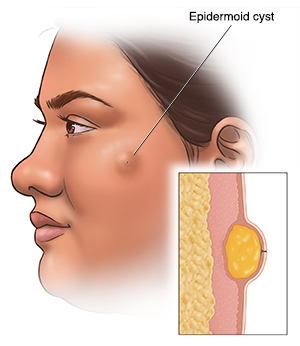A
B
C
D
E
F
G
H
I
J
K
L
M
N
O
P
Q
R
S
T
U
V
W
X
Y
Z
Topic IndexLibrary Index
Click a letter to see a list of conditions beginning with that letter.
Click 'Topic Index' to return to the index for the current topic.
Click 'Library Index' to return to the listing of all topics.
Understanding Epidermoid Cyst
An epidermoid cyst is an abnormal growth in the top layers of the skin. It's filled with keratin, the same proteins that make up your hair and nails. These cysts grow slowly. They can grow anywhere on the body. But they are most often found on the face, behind the ears, and on the chest or upper back.

How to say it
ehp-ih-DER-moid sihst
What causes an epidermoid cyst?
In most cases, epidermoid cysts occur for no known reason. Sometimes an epidermoid cyst may occur because of an injury to the skin or from acne.
Symptoms of an epidermoid cyst
An epidermoid cyst is a subcutaneous bump. This means it's just below the skin. It may be yellow or skin-colored. It often has a small black mark in the middle of it, like a blackhead.
An epidermoid cyst rarely causes pain, unless it breaks open (ruptures) or becomes inflamed or infected. It may ooze keratin, a white, cheesy, smelly material. If the cyst becomes inflamed or infected, it may be:
-
Bad smelling
-
Red
-
Swollen
-
Sore
Treatment for an epidermoid cyst
Many epidermoid cysts don’t cause any problems. They don’t always need to be treated. They may go away on their own. But you may want to treat it if you don’t like how it looks or it becomes inflamed. Or if it's in an uncomfortable place. Treatment options include:
-
Steroid injection. A steroid may be injected into the cyst. This may help ease inflammation.
-
Antibiotics. In some cases, you may need to take an oral antibiotic to treat infection and reduce inflammation.
-
Surgical removal. The cyst can be cut out. Inflamed cysts are hard to remove. They may need to be drained or treated with antibiotics or steroids before surgery. There is a slight chance the cyst may come back.
When to call your healthcare provider
Call your healthcare provider right away if you have any of these:
-
Fever of 100.4°F (38°C) or higher, or as directed by your provider
-
Redness, swelling, or fluid leaking from your incision that gets worse
-
Pain that gets worse
-
Symptoms that don’t get better, or that get worse
-
New symptoms
Online Medical Reviewer:
Michael Lehrer MD
Online Medical Reviewer:
Raymond Kent Turley BSN MSN RN
Online Medical Reviewer:
Tennille Dozier RN BSN RDMS
Date Last Reviewed:
5/1/2022
© 2000-2024 The StayWell Company, LLC. All rights reserved. This information is not intended as a substitute for professional medical care. Always follow your healthcare professional's instructions.